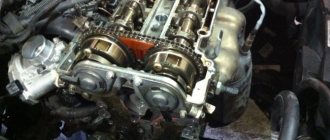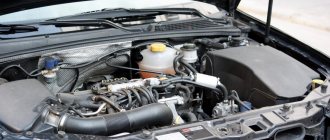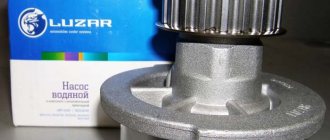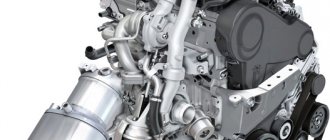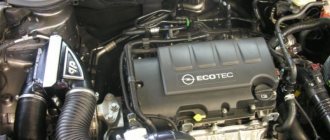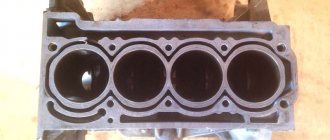The Z16XER engine is a successor to the Opel 16-valve naturally aspirated engine family. This particular engine appeared in 2007, and with it, phase shifters appeared on Opel engines, and on two camshafts at once. Therefore, the cylinder head of the Z16XER engine differs from its predecessor Z16XEP - it does not have hydraulic compensators. This engine also has a completely different intake manifold - plastic, with a mechanism for changing its length.
This power unit complies with Euro-4 environmental standards, it is more powerful and economical. On its basis, a 1.6-liter turbo engine and a more strangled engine for the sake of Euro-5 standards were built. Thus, this engine was produced until approximately 2015.
The Z16XER engine was installed on the Opel Astra H, Zafira B. Also on the Chevrolet Cruze, Tracker where it is designated F16D4.
On our YouTube channel you can watch a disassembly of the 1.6-liter Z16XER engine removed from the 2008 Astra H model.
You can select and buy an engine for Opel in our catalog of contract engines.
Z16XER engine reliability
The Z16XER engine has decent reliability and a good service life. In the first years of production, it had problems with phase regulators, which were resolved during the recall campaign. Otherwise, it has virtually no problems or serious weaknesses, although some of its features are worth knowing about so as not to have problems with repairs. Now we'll tell you everything.
Ignition coil module
The ignition coils on many Opel engines are combined into a single module. Therefore, if problems arise with it, the question arises of purchasing a new or used module. But the most common problem with this module is repairable.
Most often, insulators fail in this module - a spark pierces the plastic of the insulator right through, after which misfires occur in the corresponding cylinder.
The coil module needs to be removed, the spark breakdown location must be found - it looks like a small crack, and there is also a smell of burnt plastic. The puncture site can be milled out with a Dremel and filled with epoxy glue. This is enough to restore the functionality of the module - to eliminate the breakdown of the insulator.
You should also inspect the spark plug wells - if there is moisture or traces of moisture in them - corrosion, then you need to additionally seal the rubber rings on top of the insulators. Moisture often accumulates in spark plug wells during the winter or after washing the engine.
Another factor leading to insulator breakdown is poor contact of the tip spring with the spark plugs.
You can select and buy an ignition coil for an Opel engine in our catalog of contract spare parts.
Throttle valve and idle speed control
The Opel X20XEV engine is controlled by a cable-actuated throttle valve and a potentiometer (sensor) of its position. This simple damper works very well and does not create any problems. But the position sensor may fail, as evidenced by either an error or inadequate engine response to the accelerator pedal. That is, noticeable pauses or a complete lack of response to the pedal.
Most often, the idle air control valve causes trouble. Here the regulator rod is driven not by a stepper motor, but by a solenoid. This is the so-called torque-type regulator.
Due to the jamming of the idle air control valve, the engine may stall when releasing the gas, and the idle speed may float or stay too high or low.
In most cases, cleaning the regulator valve helps: the bypass channel and valve become clogged with oil and soot that are present in the intake manifold. If the regulator becomes dirty quickly, literally within a couple of months, then you need to check the crankcase ventilation system. We'll talk about this later.
Also, a lot of soot and oil get into the solenoid housing. The bravest owners and servicemen flare the regulator body and clean the solenoid. After such intervention and assembly, the regulator needs to be adjusted, namely, the pressure of the valve stem to the solenoid core must be adjusted.
You can select and buy a throttle valve for an Opel engine or an idle speed controller for an Opel engine in our catalog of contract engines.
ECU
Sometimes Opel vehicles with the Z16XEP engine may experience errors that may be unrelated to each other. In this case, the problem may be in the ECU, namely in the soldering of the pins of the electrical connectors and the electronic board. But before opening the ECU, you should clean and lubricate the electronic connectors - sometimes this helps. In general, the control unit is located poorly - on the engine intake manifold, so it is subject to vibrations and temperature changes.
Thermostat
The Z16XEP engine is equipped with an electronically controlled thermostat. It fully opens at a temperature of 105°C, but if the engine is under high loads, the thermostat opens earlier - at 90°.
The thermostat is opened by a heater built into it. The ECU learns about a high load on the engine from the data of an additional temperature sensor built into the radiator of the cooling system. The engine management system can compare the coolant temperature in the radiator and near the thermostat and record the corresponding errors, which indirectly indicate poor thermostat performance. This helps prevent the engine from overheating, a common hazard.
As practice has shown, this thermostat lasts about 50,000 km. A good non-original replacement costs about $50, the original is much more expensive.
Heat exchanger
The Z16XER engine is known for the appearance of an oil emulsion in the cooling system - the oil “floats” in the expansion tank. But the opposite situation may occur - coolant will flow into the oil, which will lead to unpleasant consequences in the form of wear of the oil pump and liners. Oil and coolant may also leak outward, running down the cylinder block directly onto the exhaust pipe. It is believed that premature problems with the heat exchanger on this engine begin due to the fact that during winter operation the driver loaded the engine heavily and early, not allowing it to properly warm up. Those. the liquid circulating through the heat exchanger heated up faster and more strongly than the heat exchanger and cylinder block.
In almost all cases, the reason lies in the gaskets under the heat exchanger. They need to be replaced and the cooling system flushed. It is best to change these gaskets preventively every 150,000 km or more often. In addition to replacing the heat exchanger gaskets themselves (there are 3 of them), you need to change the O-rings on the antifreeze supply and discharge pipes - 8 positions in total.
There are also rare cases of cracks appearing inside the heat exchanger, so after removing it to replace the gasket, it is not a bad idea to blow it out. You need to apply minimum pressure to one of the cooling system pipes and plug the other. This way you can make sure that the antifreeze circuit is tight.
Injectors
The injectors of the Opel X20XEV engine have only 2 holes for spraying fuel; in general, they serve well.
But if the injectors are clogged, the engine develops very sluggishly after 4000 rpm, and may also have difficulty starting when hot. If the injectors become clogged, they can be replaced with any suitable ones. Volga injectors are suitable here.
Also, injectors can leak fuel or leak air through their sockets, which can be treated by replacing the O-rings.
You can select and buy gasoline injectors for an Opel engine in our catalog of contract engines
VKG valve
The Z16XER engine has a known problem with the diaphragm rupture of the crankcase ventilation valve. The crankcase ventilation valve is located in the valve cover and is part of it. Therefore, the plant does not provide for replacing the VKG valve separately from the valve cover.
But a solution has long been found: this valve can be disassembled by removing its inner cover. After this, you can replace the membrane - there are plenty of substitutes now. Workshops also offer valve covers with a replaced diaphragm in exchange for the customer's cover.
Symptoms of a burst VKV valve membrane primarily manifest themselves in the form of unstable and jumping revolutions. Also, a crack in the membrane is indicated by strong suction of the oil filler plug. Another sign: very unstable engine idling when removing the plug or removing the dipstick. If there is a crack in the membrane, a whistle of air is heard through the hole in its body in the valve cover; this whistle disappears when the dipstick is removed or the plug is unscrewed.
If the membrane is not damaged, then the whistle will not be heard at all, the engine will be able to operate stably with the dipstick removed and the plug removed.
You can select and buy a valve cover for an Opel engine in our catalog of contract spare parts.
Crankcase ventilation system
Clogging of the crankcase ventilation system pipes on the X20XEV engine is often the cause of unstable engine operation. For example, the idle speed may drop briefly when the accelerator is fully released on a car with a manual transmission or when the automatic transmission is switched to “park” or “neutral”.
Typically, in the VCG system, the tube coming out of the engine block on the exhaust manifold side becomes clogged. If, due to soot, its cross-section decreases, then the gas pressure in the crankcase increases. This tube can be cleaned or replaced with a new one.
We also add that between this tube and the tube on the valve cover you can install a standard oil separator (9201848). It is a plastic box with a steel “sponge” inside. If your throttle body, idle speed control, and overall intake manifold are quickly becoming clogged with oil, this oil separator can help.
Phase shifters and control valves
Both camshafts of the Z16XER engine are equipped with phase shifter clutches. With high mileage and the use of low-quality oil, these clutches may produce frequent knocking or cracking noises in the first few seconds after starting the engine. Sometimes this knock, popularly called “dieseling,” is confused with the knock of hydraulic compensators. But there are no hydraulic compensators in the cylinder head of the Z16XER engine.
The phase shifters knock due to deterioration in the oil supply: the oil pressure is enough to squeeze out the clutch rotor retainer, but not enough to fill its chambers. This occurs due to clogging of the control valve screens, clogging of the oil channels, jamming of the pressure reducing or safety valve and wear of the couplings themselves. But a brief knock is only the first symptom of emerging problems.
If the functioning of the variable valve timing system is disrupted, the ECU records the corresponding errors indicating a short-term or permanent failure (errors P0010, P0011, P0013, P0014).
At the beginning of the release of the Z16XER engine, recall campaigns were carried out: first, the manufacturer changed the phase shifters under warranty, and then the electro-hydraulic valves.
Each clutch is controlled by a separate solenoid valve. When one of the valves jams, phase control stops. In this case, the clutch will take either one of the extreme positions, depending on the position in which the solenoid valve rod gets stuck. If the control valve is jammed, oil is constantly supplied to the corresponding clutch, which soon leads to the camshaft oil seal being squeezed out. Squeezed oil can get onto the timing belt and cause it to jump.
Solving problems with knocking phase shifters and errors in the operation of this system may take a long time. It often happens that after replacing both couplings (55567048 and 55567049) and valves (55 567 050), knocking or errors persist. Then you need to double-check all options: inspect the oil line and the condition of the valves in the oil pump. In any case, all the troubles come down to saving on engine oil.
Thermal clearances
The Z16XER engine does not have hydraulic compensators in the valve drive, so it needs to adjust the thermal clearances. The manufacturer requires this adjustment to be made every 150,000 km. The nominal thermal clearance of the intake valves is 0.25 mm, and the exhaust valves are 0.31 mm. Adjusting the gaps is carried out in the most labor-intensive way - by selecting calibrated pushers. That is, you need to measure the existing clearances, raise the camshafts, and then calculate the size of the adjustment tappets based on the current size of the clearances and tappets.
You can choose and buy an engine for Opel Astra, Opel Meriva or Opel Zafira, Opel Vectra in our catalog of contract engines.
Here, using the links, you can see the availability of specific Opel cars at the dismantling station and order auto parts from them.
EGR valve
A sticking EGR valve on a gasoline engine is the culprit of the engine's rough idling, as well as the cause of slight dips during acceleration. Usually the EGR valve on the X20XEV engine works without hassle. Many people suppress it by installing a plug on the exhaust gas supply. But in this case, it is better to remove the valve and fill the ECU with firmware for operating the engine without an EGR system. Because if the supply of exhaust gases is simply blocked, fuel consumption may increase.
You can select and buy an EGR valve for an Opel engine in our catalog of contract engines.


